
Harrismith
After Winburg and Bloemfontein, this the third oldest town in the Free State. It is the industrial centre of the area, which in 2011, according to Wikipedia, had 28000 inhabitants. Its geo-location: 28.2701°S, 29.1249°E and altitude 1643m. The most significant feature is the Platberg, a long, flat-topped mountain, which cannot be over looked.
History
 It started with the British taking over the Free State in 1848. That was following the battle of Boomplaas. The governor of the Cape, Harry Smith immediately appointed one of his former enemies, PM Bester, as the magistrate of the eastern district, that was the area between the Vaal river, the Sandspruit and the Drakensberge to the south. It was called the Vaalriver district. One of the instructions given to Bester was that he should find a site where a town could be developed.
That was no problem for him, when he was a member of the volksraad in Natal during 1842 plans were already made to have a town at the Elands river, 16 km west from the later Harrismith.
It started with the British taking over the Free State in 1848. That was following the battle of Boomplaas. The governor of the Cape, Harry Smith immediately appointed one of his former enemies, PM Bester, as the magistrate of the eastern district, that was the area between the Vaal river, the Sandspruit and the Drakensberge to the south. It was called the Vaalriver district. One of the instructions given to Bester was that he should find a site where a town could be developed.
That was no problem for him, when he was a member of the volksraad in Natal during 1842 plans were already made to have a town at the Elands river, 16 km west from the later Harrismith.
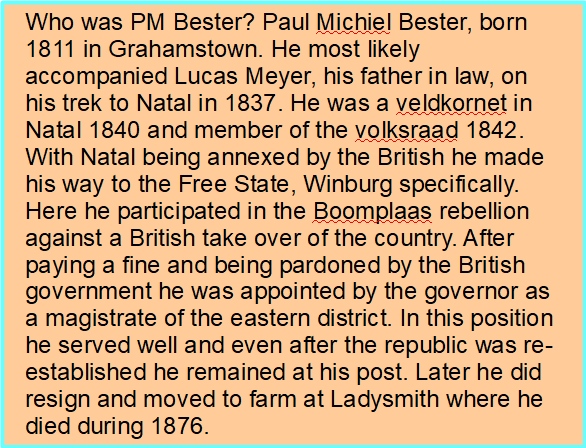 It was quickly established that there was a problem with the site at Elands river, it was the water supply. Some major work was required to secure the water supply to the new town, for which there was no money.
It was quickly established that there was a problem with the site at Elands river, it was the water supply. Some major work was required to secure the water supply to the new town, for which there was no money.
A new site was found next to the Platberg on the banks of the Wilge river. The 13950 hectare farm was bought from Jan Snyman for a consideration of £37 and 10 Shilling. Survey pegs were placed and work commenced on the channel to get water to the future town. Credit was given to the purchasers of stands by giving them equivalent sites in the new place. The first auction was held on the 16 January 1850. It was reported that in August 1852 there were 40 completed houses, with the walls being stacked sod.
About the naming of the place. In a letter to the governor, Bester suggested Vredenburg or Harrismith, the reply was that the governor prefers the former. But Bester, obviously versed in the art of politics, still decided on the latter.
And 1851 it was reported that there are 120 people of European descent living in the new town of which 28 are arms-carrying men. One aspect on this to be mentioned is that most of the inhabitants were English speakers. A situation that didn't change for many years. English speakers only lost their majority in the council in 1955. Most of them came from Natal and it is not surprising that in the 1860th there was agitation for Harrismith to be incorporated into Natal.
Some milestones in the towns history, Harrismith became a municipality during 1875 and in 1892 the railway had reached the town connecting it to Durban.
Town-hall
 A majestic building, erected in 1907/8. The cornerstone was laid by Sir Hamilton Coolt-Adams, governor of the Orange River Colony on the 2 October 1907.
A majestic building, erected in 1907/8. The cornerstone was laid by Sir Hamilton Coolt-Adams, governor of the Orange River Colony on the 2 October 1907. 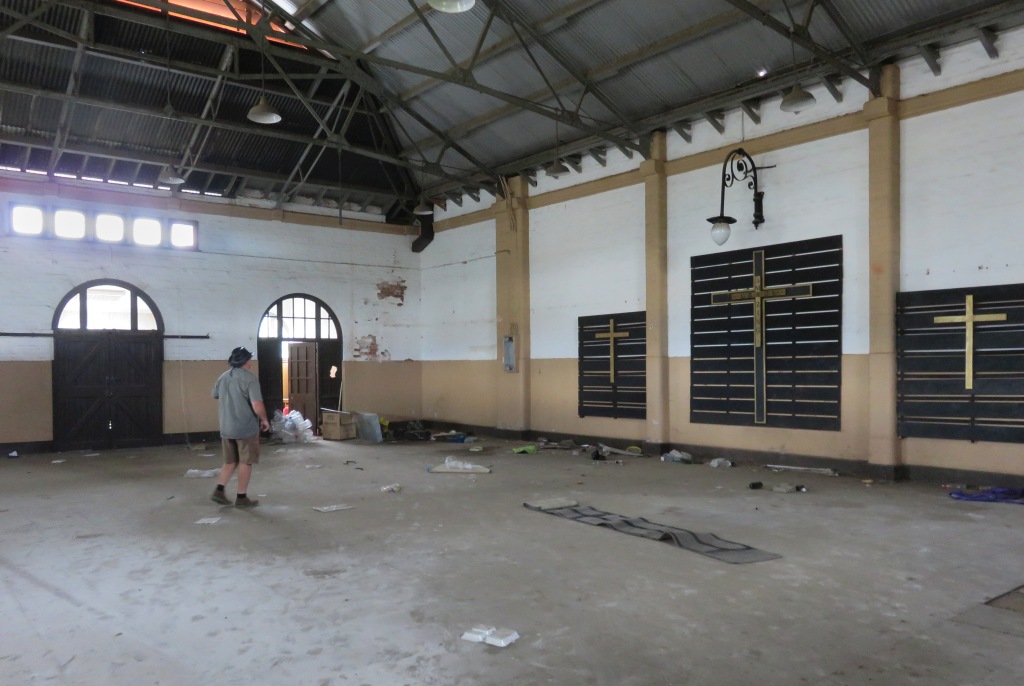 A perfectly intact building, but it is not used for that purpose. In fact, I noticed a new municipal admin building just behind. To me it looks like a waste of money. Why build a new one when the old one was still available?
The hall is full of rubbish and nobody cares. What is the world coming to? I am not going to answer that.
A perfectly intact building, but it is not used for that purpose. In fact, I noticed a new municipal admin building just behind. To me it looks like a waste of money. Why build a new one when the old one was still available?
The hall is full of rubbish and nobody cares. What is the world coming to? I am not going to answer that.
 The monuments around the town hall. On the south side is the monument to honour the fallen soldiers of the 1st and 2nd world war. On the other side of the town hall is the monument for the British soldiers who died in the area during the Anglo-Boer war (1899-1902).
The monuments around the town hall. On the south side is the monument to honour the fallen soldiers of the 1st and 2nd world war. On the other side of the town hall is the monument for the British soldiers who died in the area during the Anglo-Boer war (1899-1902).  Also on the north side is the fossilised tree, it is 33m long and was alive 250 million years ago. And just over the road is the burger monument. But this one has a story and I will cover it under a separate heading.
Also on the north side is the fossilised tree, it is 33m long and was alive 250 million years ago. And just over the road is the burger monument. But this one has a story and I will cover it under a separate heading.
A little gem I found near the burger monument, a classical fire hydrant. Sorry about the litter, I could have cloned it out, but decided not to. This is photo journalism. And whilst on the topic of cleanliness, in Ref 1 under Harrismith I found the following sentence: The Debora Retief Garden, which contains two war memorials and a petrified tree, 30 metres long and probably 150 million years old, is a beauty-spot in the centre of town. Well, no more, the place is full of rubbish and the road surfaces are in a shocking state. I wasn't going to mention this, but my pot just boiled over.
Sorry about the litter, I could have cloned it out, but decided not to. This is photo journalism. And whilst on the topic of cleanliness, in Ref 1 under Harrismith I found the following sentence: The Debora Retief Garden, which contains two war memorials and a petrified tree, 30 metres long and probably 150 million years old, is a beauty-spot in the centre of town. Well, no more, the place is full of rubbish and the road surfaces are in a shocking state. I wasn't going to mention this, but my pot just boiled over.
Burger monuments

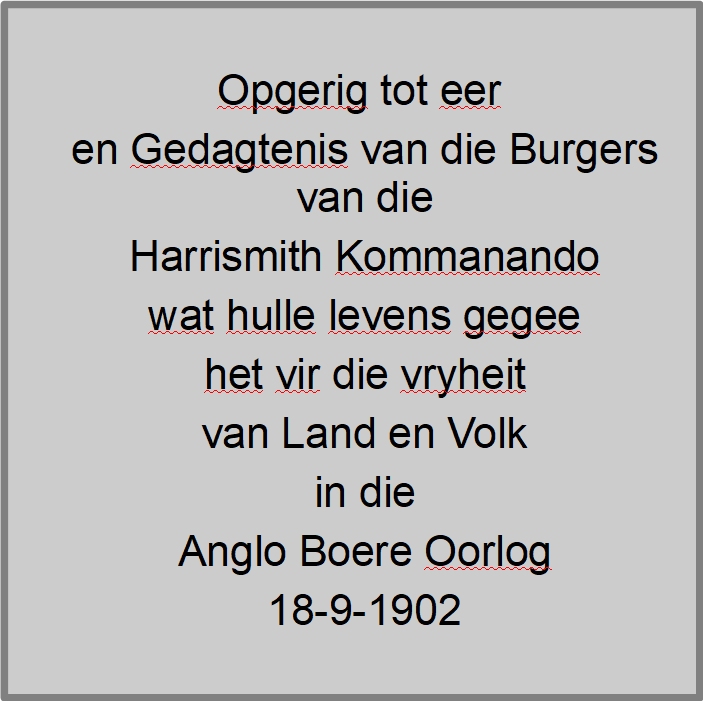 There are two monuments to honour the dead from the republic side, and if one adds the memorial stone at the cemetery there are three. The first one was erected near the NG church very soon after the end of the war.
There are two monuments to honour the dead from the republic side, and if one adds the memorial stone at the cemetery there are three. The first one was erected near the NG church very soon after the end of the war.
The front side, facing north, has the dedication of the monument, which is shown in the text box on the right. Translation:
Erected in memory of the burghers of the Harrismith commando who gave their lives for the freedom of the country and the nation during the Anglo Boer war. 18-9-1902
The other sides give the names of soldiers who died in different theatres of the war. East: 21 names who died as prisoners of war, west: 33 names of soldiers who died at different places and the South face is dedicated to the warriors who died fighting the battle of Platrand. A battle that took place on the 6 Jan 1900 to the south of Ladysmith. It was part of the siege of Ladysmith.
 The second monument to honour the burgers who lost their lives and those of the woman and children in the concentration camps, is on the square just across from the town hall. And that one has a bit of a story to it.
The second monument to honour the burgers who lost their lives and those of the woman and children in the concentration camps, is on the square just across from the town hall. And that one has a bit of a story to it.
I have alluded to that before, the population of the town was mostly English speakers. This caused problems at the start of the Anglo Boer War. As per law any white person staying in the Free State for more then 3 years had to make themselves available for the defence of the country. Some did, some left the country and a few went to Natal to joine the Natal Carabineers supporting the British army.
Thus one can imagine that the proposal of a Boer monument did not have an overwhelming support. No agreement on the location could be reached in the council meetings, it had to be taken to a rate payers meeting, where the proposal to place it across from the town hall was agreed on with a narrow majority.
The monument was opened, coinciding with the 100 year trek commemorations, on the 8 November 1938. But that was not the end of it, more drama was to follow.
War broke out in 1939 with South Africa on the side of Great Britain and many of the Afrikaans speaking people not approving of this, they would have preferred to keep South Africa out of the conflict.
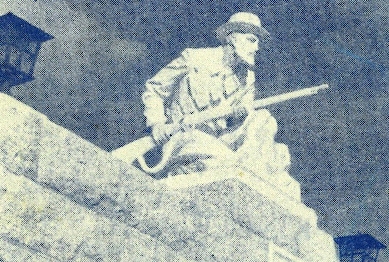 During the night of the 1 March 1940 the monument was vandalised. Although there were some suspicions, it is not known for certain who did it. The statue on top was damaged, the perpetrator using a water pipe to hit off parts of the hat and the gun. The picture shows what it originally looked like.
During the night of the 1 March 1940 the monument was vandalised. Although there were some suspicions, it is not known for certain who did it. The statue on top was damaged, the perpetrator using a water pipe to hit off parts of the hat and the gun. The picture shows what it originally looked like.
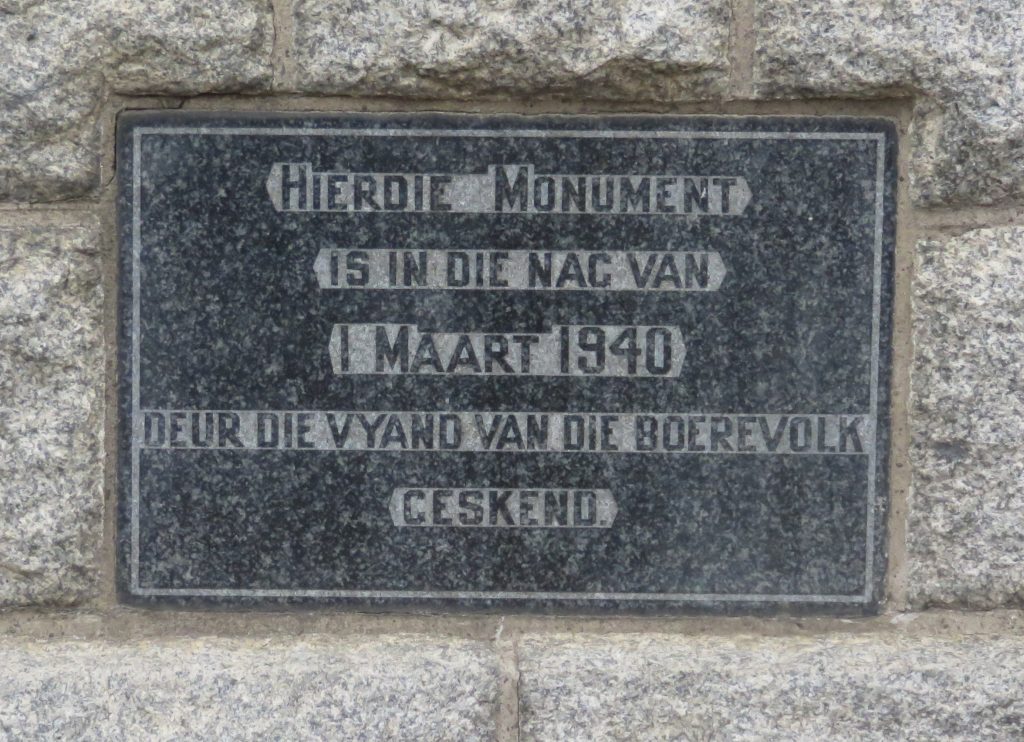 Immediately a fund was established by the English business men to affect repairs to the statue. That was done by the original builders of the monument free of charge and the gun glued back on. Everybody should have been happy now, not so. Some of the Afrikaans population did not want the monument repaired, but rather keep it in the damaged state as a reminder of the sufferings of their nation. This group eventually won, the piece of the broken off rifle was removed again and hidden. A plaque was added to explain the state of the monument, see picture. Translated it reads: This monument was vandalised in the night of the 1-March-1940 by the enemy of the Boer Nation.
Immediately a fund was established by the English business men to affect repairs to the statue. That was done by the original builders of the monument free of charge and the gun glued back on. Everybody should have been happy now, not so. Some of the Afrikaans population did not want the monument repaired, but rather keep it in the damaged state as a reminder of the sufferings of their nation. This group eventually won, the piece of the broken off rifle was removed again and hidden. A plaque was added to explain the state of the monument, see picture. Translated it reads: This monument was vandalised in the night of the 1-March-1940 by the enemy of the Boer Nation.
Free Mason hall
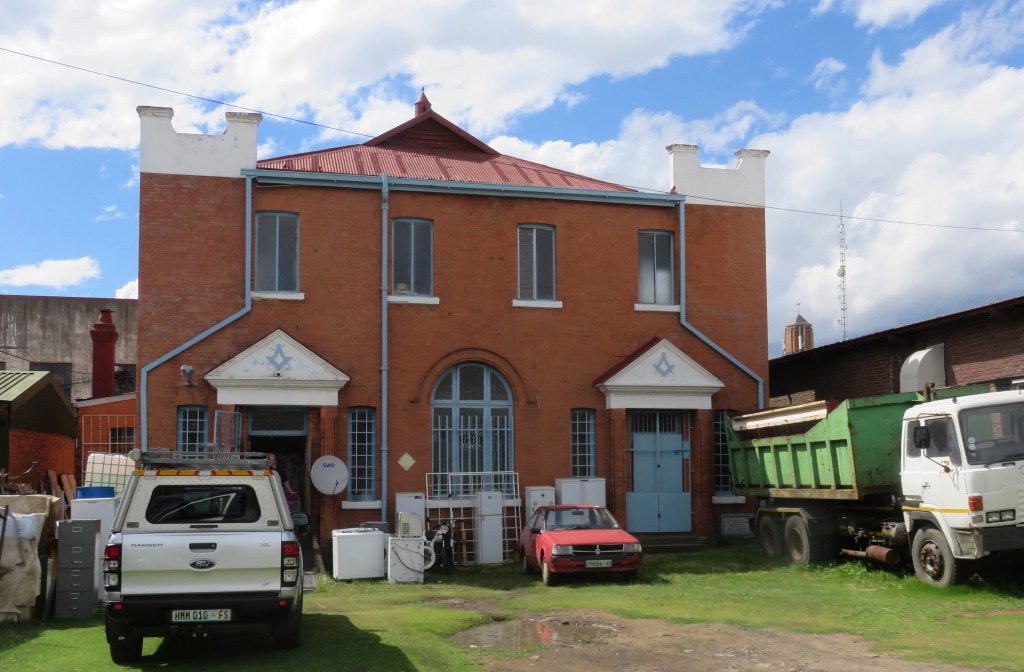
 Passing a building with masonic symbols we had to stop and check it out. Yes, it was the Masonic centre, and is still in use by the free masons. Although the ground floor has been taken up by a used goods shop (Piet found some interesting books there). The top floor, to which we had no access, is still in use by the lodge.
Passing a building with masonic symbols we had to stop and check it out. Yes, it was the Masonic centre, and is still in use by the free masons. Although the ground floor has been taken up by a used goods shop (Piet found some interesting books there). The top floor, to which we had no access, is still in use by the lodge.
The lodge was started in Harrismith in 1878, until they built their own centre they used different localities for their meetings, including the school. 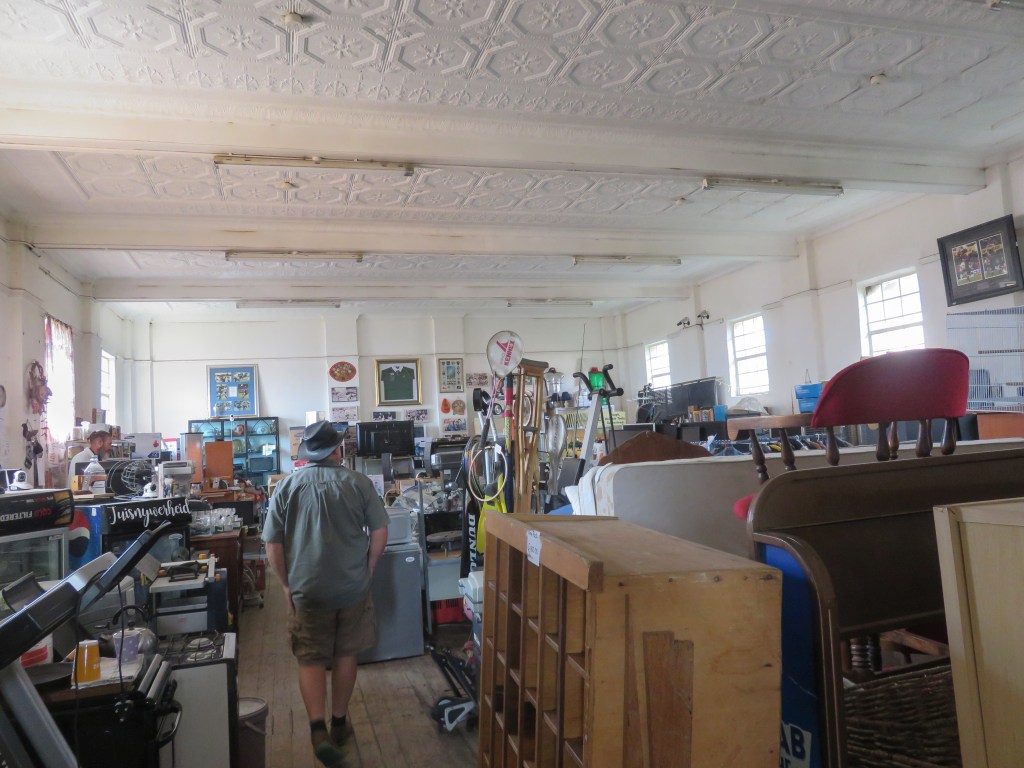 1891 they bought the stand for £250 on which this building was later erected. The corner stone states that it was laid on the 24 June 5912. The year was actually 1912. Was it just a mistake? Unlikely, or is there some symbolism behind this?
1891 they bought the stand for £250 on which this building was later erected. The corner stone states that it was laid on the 24 June 5912. The year was actually 1912. Was it just a mistake? Unlikely, or is there some symbolism behind this?
One of the well known people to join the lodge was General Rundle of the British army, who was stationed here in 1901/02 and was last in charge of the defence of the north east Free State.
Anglican church

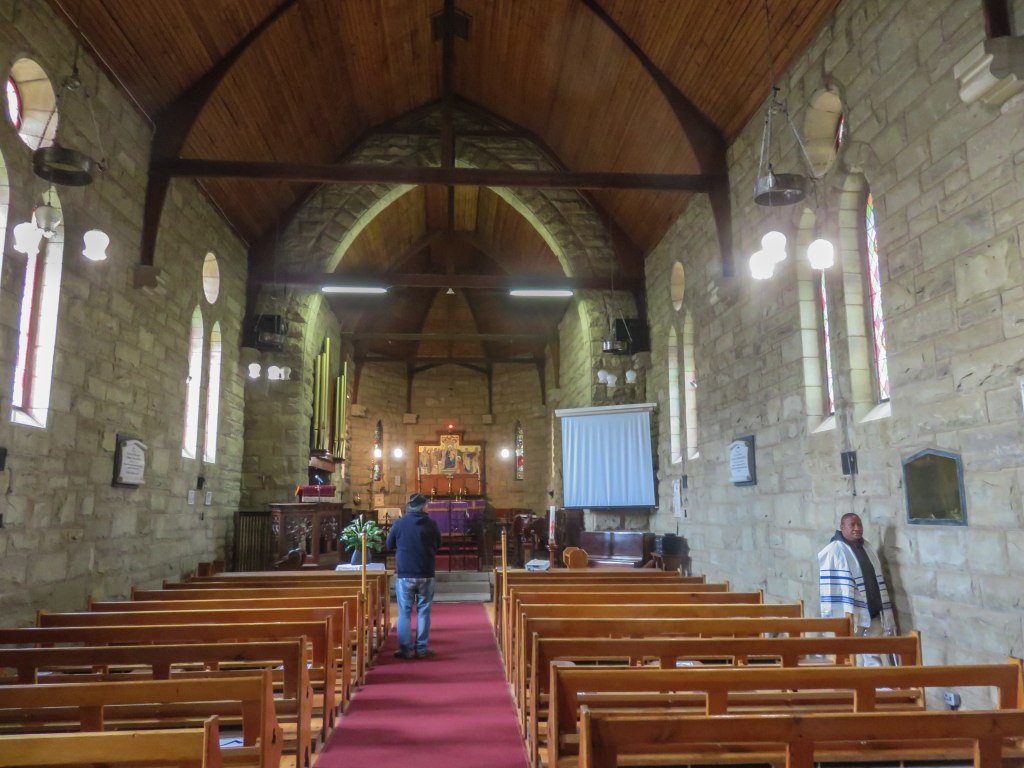 The church of St.John the Baptist.
As mentioned above, from the beginning there was a strong English speaking population and thus also a need for a place of worship. But numbers for individual denominations was low, thus 1867 they got together and build a union chapel, that was for the three denominations, Anglican, Wesleyan/Methodist and Presbyterian.
The church of St.John the Baptist.
As mentioned above, from the beginning there was a strong English speaking population and thus also a need for a place of worship. But numbers for individual denominations was low, thus 1867 they got together and build a union chapel, that was for the three denominations, Anglican, Wesleyan/Methodist and Presbyterian.
For the initial years the Anglican community had to rely on visiting preachers, but in 1871 a full-time preacher, Rev W.Clarke, was appointed.
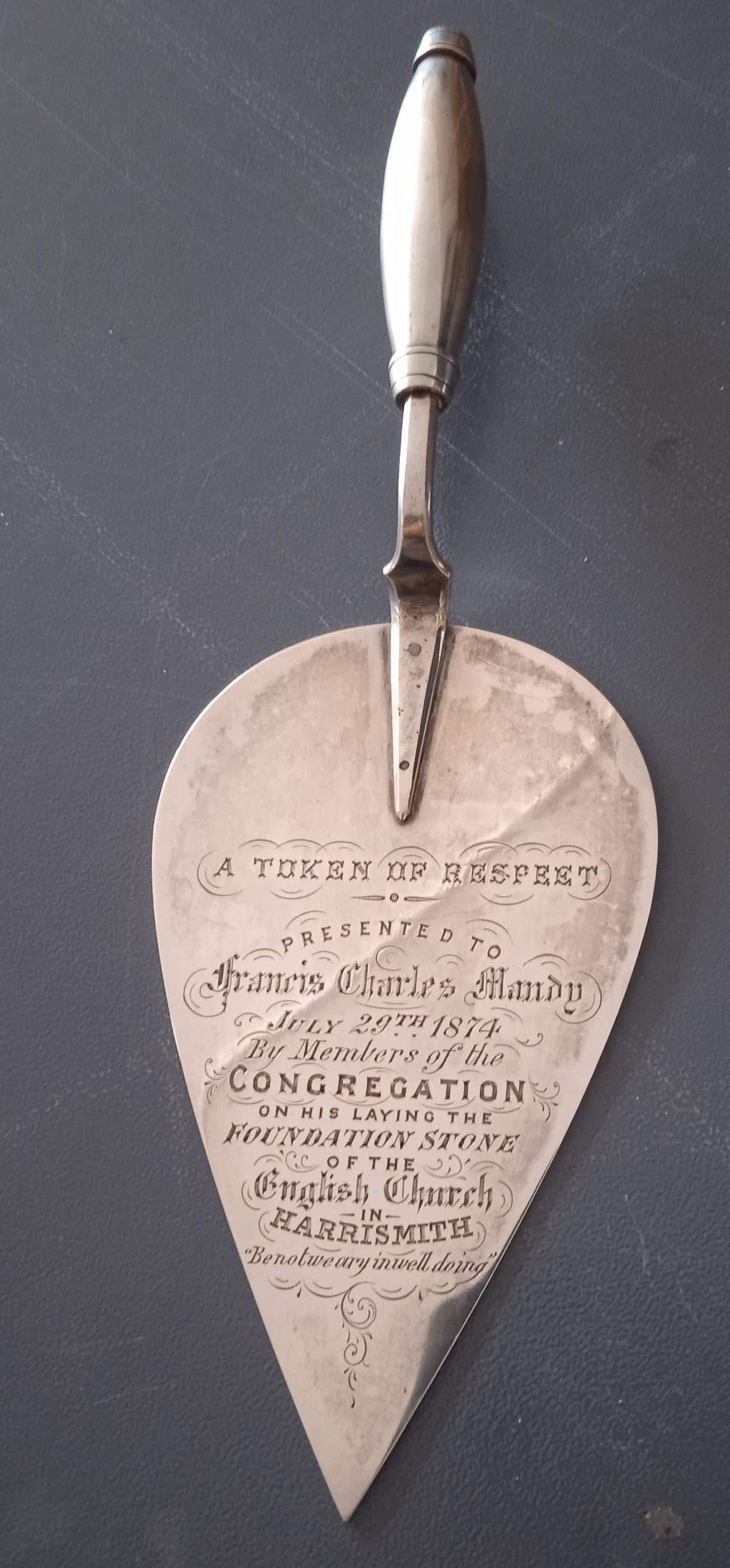 Funds were collected, the stand was donated by the volksraad and a small church build in 1875. The major donor was FC Mandy, who gave £200 and lent £300. For such a generous gesture he could lay the foundation stone and receive a silver trowel as a memento, see picture. The text on it: (semicolon indicates line break) A token of respect; presented to; Francis Charles Mandy; July 29th 1874; by members of the; Congregation; on his laying the; foundation stone; of the; English Church; in; Harrismith; be not weary in well doing.
Funds were collected, the stand was donated by the volksraad and a small church build in 1875. The major donor was FC Mandy, who gave £200 and lent £300. For such a generous gesture he could lay the foundation stone and receive a silver trowel as a memento, see picture. The text on it: (semicolon indicates line break) A token of respect; presented to; Francis Charles Mandy; July 29th 1874; by members of the; Congregation; on his laying the; foundation stone; of the; English Church; in; Harrismith; be not weary in well doing.
It had to be build twice after some problems were noted with the foundations. It required the walls to be brought down, the foundation strengthened and the walls taken up again. It was finally completed in Feb 1877.
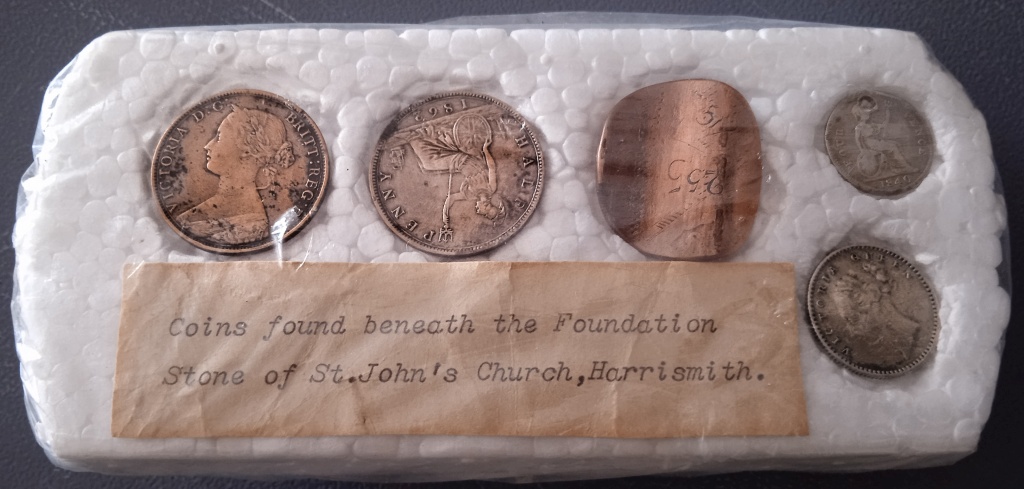 This small church was demolished in 1906 to make room for a new building, the present one. The foundation stone was laid by H.R.H.Arthur William Patrick Albert, the Duke of Connaught and Strathearn, 14 Feb 1906. The Duke, at the time, was on an inspection tour of the Harrismith garrison.
This small church was demolished in 1906 to make room for a new building, the present one. The foundation stone was laid by H.R.H.Arthur William Patrick Albert, the Duke of Connaught and Strathearn, 14 Feb 1906. The Duke, at the time, was on an inspection tour of the Harrismith garrison.
Whilst digging the foundations they unearthed some coins, see picture. One has to assume they are from the time when the first church was being build.
 I am only able to identify two I coins, they are all British, with exception of the 3rd from the left, which more looks like a token. We have here a half penny minted 1862 and four pence of 1840.
I am only able to identify two I coins, they are all British, with exception of the 3rd from the left, which more looks like a token. We have here a half penny minted 1862 and four pence of 1840.
The pulpit has a bit of a story. It was built and donated by British soldiers of the garrison. The plaque reads: Erected by the Officers, non-commissioned officers, and men of the; 2nd Battalion East Yorkshire Regiment, in memory of their comrades; (6 officers, 6 non-C.O.'s, and 80 men.);who fell in the South African war. 1900-1902. There are also a number of stained glass windows, the one shown depicts the birth of Jesus Christ.
NG church
 The Nederduits Gereformierde Kerk had an early beginning. There was a note in the newspaper, Natal Witness, that a foundation stone for a church was already laid in May 1849 at the first site on the Elands river. But we know, that had to be given up. The beginning in Harrismith was not that quick. The congregation of the NG church was officially established in 1849 through the initiative of Dr Andrew Murray. Church services were held in the school as soon as that became available, until a proper church was build. The first church building was completed in 1873.
The Nederduits Gereformierde Kerk had an early beginning. There was a note in the newspaper, Natal Witness, that a foundation stone for a church was already laid in May 1849 at the first site on the Elands river. But we know, that had to be given up. The beginning in Harrismith was not that quick. The congregation of the NG church was officially established in 1849 through the initiative of Dr Andrew Murray. Church services were held in the school as soon as that became available, until a proper church was build. The first church building was completed in 1873.
For the initial 12 years the congregation was not able to appoint a full time preacher. That was because of the congregation being too small and the availability of qualified people limited. It was only in 1862 that Ds.MacMillan arrived to take up the post. He was from Scotland and had spent 7 month in Holland, before he came here, to learn the language. He also doubled up as a English preacher to help the English speaking community. After 12 years at his post he went back to Scotland.
A new church had to be built, inaugurated in 1892, see picture. The main building material was the sand stone from the area. And finally in 1967 the old church was demolished and a new one erected. This is the one seen behind the burgher monument.
Mosque

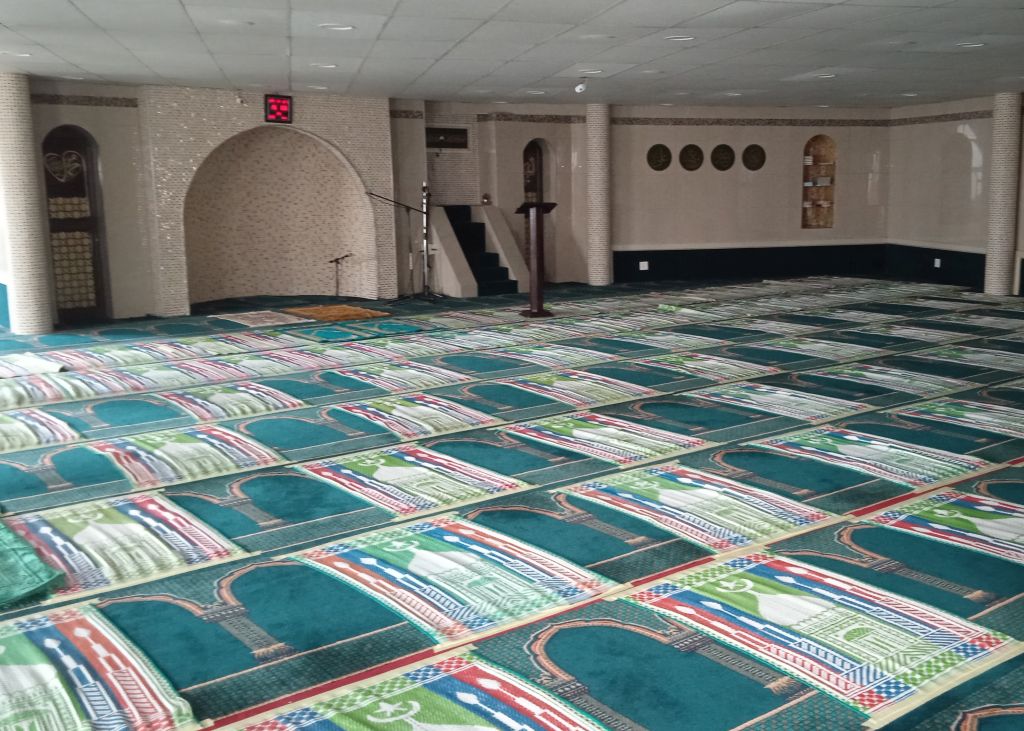 There are two mosques in town. We came across this one because on the corner of the property was a sign that said 'AGS kerk', but this was not a church, it looks like a mosque. So, we had to investigate. It turned out that we had overlooked the arrow on the sign that pointed down the road.
There are two mosques in town. We came across this one because on the corner of the property was a sign that said 'AGS kerk', but this was not a church, it looks like a mosque. So, we had to investigate. It turned out that we had overlooked the arrow on the sign that pointed down the road.
The mosque had an interesting history. When initially the community bought the property it had an old house on it. It was old enough to receive monument status. The town council refused permission to pull it down. The solution was to build the mosque around the old building. This can still be seen by the double roof. The old roof is still there and visible, with the new roof on top of it. We did not get a date when all that happened. It must have been after 1990 which is the year the group areas act was repealed.
The property has been further developed to include other buildings, some quarters for the staff, a ladies hall (men and woman are separated for prayer) and a kitchen. And notice the carpet in the prayer hall is not parallel with the walls, it is at a skew angle so that it points to Mecca. This was the solution to the problem that the new building could not be aligned into the correct direction.
I was positively impressed by the openness and friendliness we found when talking to the people at the mosque.
The Bridge
 That is the bridge over the Wilge river. It was constructed at the same time as the town hall. The commemorative plaque states: This bridge was opened by his excellency Sir Hamilton Coold-Adams o.c.M.G.C.B. governor of the Orange River Colony August 2nd 1907.
That is the bridge over the Wilge river. It was constructed at the same time as the town hall. The commemorative plaque states: This bridge was opened by his excellency Sir Hamilton Coold-Adams o.c.M.G.C.B. governor of the Orange River Colony August 2nd 1907.
The Railway station
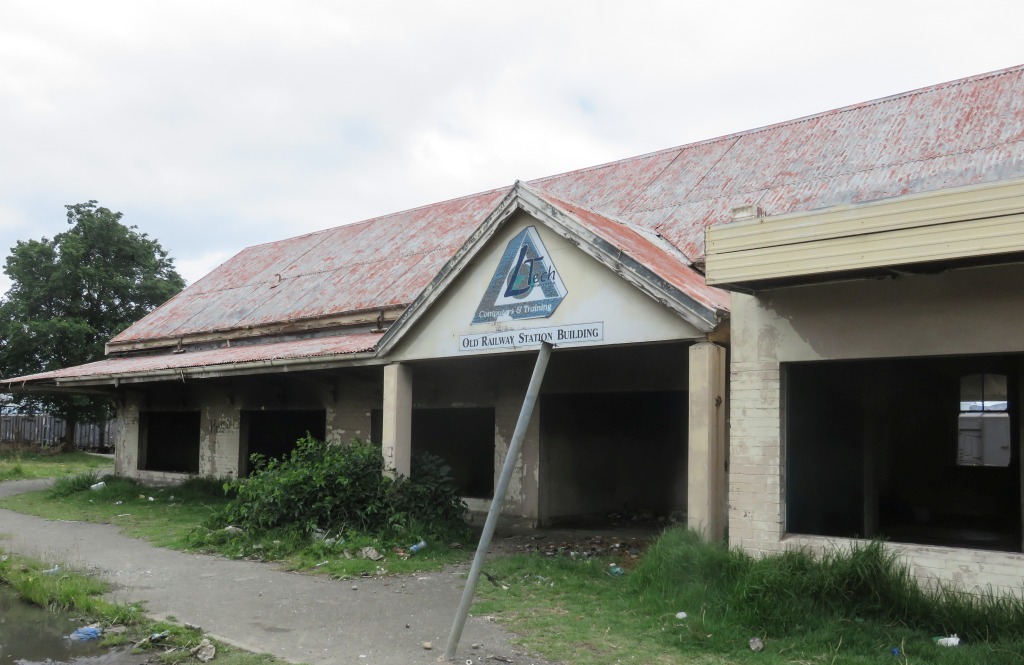
 The rail link to Ladysmith was completed 1892. This connected Harrismith to the coast. It was later extended to finally link to Kroonstad 1906. A branch line to Warden came in 1926.
The rail link to Ladysmith was completed 1892. This connected Harrismith to the coast. It was later extended to finally link to Kroonstad 1906. A branch line to Warden came in 1926.
The mainline to Bethlehem and Kroonstad is still active, although it doesn't look like passenger service still features. The main station building is an empty ruin.
M.O.T.H. hall
 I would normally not pay much attention to a building like this, it's just a normal structure and not very old. What makes this place interesting is that it is stuffed full of history, mostly around the Harrismith commando.
I would normally not pay much attention to a building like this, it's just a normal structure and not very old. What makes this place interesting is that it is stuffed full of history, mostly around the Harrismith commando.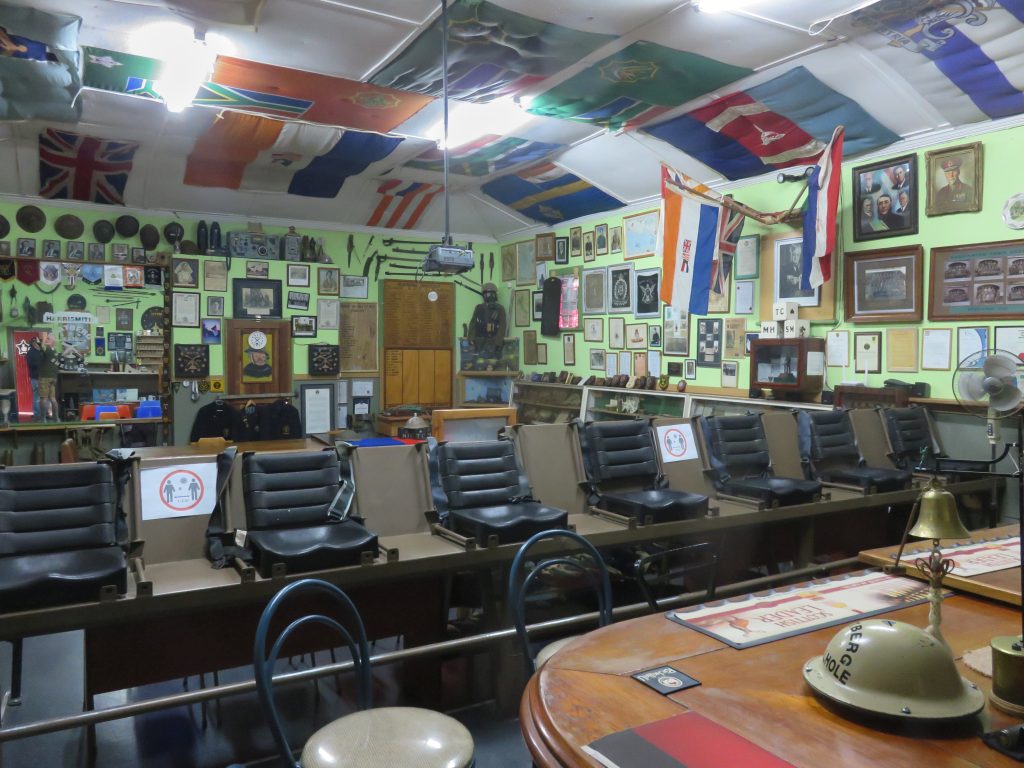
What does M.O.T.H. stand for? It is the Memorable Order of Tin Hats, a war veterans organisation initially established for soldiers who had fought in the 1st World War but later extended to other wars.
the block house
 A substantial blockhouse, it was built during the Anglo Boer war to guard the town's water supply. It is in, what is called the Botanical Garden, just outside town on the slopes of the Platberg.
A substantial blockhouse, it was built during the Anglo Boer war to guard the town's water supply. It is in, what is called the Botanical Garden, just outside town on the slopes of the Platberg.
The Cemetery
British Anglo Boer War graves

 British forces occupied the town during August of 1900 and a number of military camps were established around the town and remained there for the duration of the war. A military cemetery was soon established and by the end of hostilities 262 soldiers had been interred here. There was relatively little military action in the area, most of the death were due to enteric fever.
British forces occupied the town during August of 1900 and a number of military camps were established around the town and remained there for the duration of the war. A military cemetery was soon established and by the end of hostilities 262 soldiers had been interred here. There was relatively little military action in the area, most of the death were due to enteric fever.
 A grave of note is that of Dr.Reid, see picture. The text reads (semicolon indicates line break): For King and Country; in memory of; Dr.Godfrey Forrest Reid; of Bethlehem; who died at Harrismith from wounds; received at the battle of Tweefontein; Christmas 1901, aged 42; erected by a few sorrowing friends.The battle of Tweefontein is synonym with the battle of Groenkop. Tweefontein is the name of the farm and Groenkop the mountain. I have written about the skirmish or battle of Groenkop in the page about Kestell.
A grave of note is that of Dr.Reid, see picture. The text reads (semicolon indicates line break): For King and Country; in memory of; Dr.Godfrey Forrest Reid; of Bethlehem; who died at Harrismith from wounds; received at the battle of Tweefontein; Christmas 1901, aged 42; erected by a few sorrowing friends.The battle of Tweefontein is synonym with the battle of Groenkop. Tweefontein is the name of the farm and Groenkop the mountain. I have written about the skirmish or battle of Groenkop in the page about Kestell.
Dr.Reid was born 1858 in Georgia USA, after his studies to become a medical doctor he moved to Ireland where he got married to Marion Dalton. 1883 he came to Bethlehem and opened a practise on the corner of Boshoff and Murray street. Since 1888 he was district surgeon and from 1889 to 1895 mayor of Bethlehem. His wife died 1895, he never remarried.
During the occupation of Bethlehem by the British he was appointed chairman of the management committee. In 1901 he joined the British army as a civilian doctor.
He was in the camp at Groenkop when the Boers attacked very early in the morning of Christmas day 1901. In that skirmish he was badly wounded, taken to the Aberfeldy field hospital, he succumbed to his wounds the day after. His remains were taken to the Harrismith cemetery and burried with full military honours.
There was an incident during the burial which I like to mention. Next to the British grave yard, separated by a stone wall was the burial ground for the concentration camp. The women in that section had also been busy with a burial. When the burial ceremony of Dr.Reid was under way they were hissing, making the sound of a snake. I don't fully understand this, but it was apparently an insult to the British. This was reported to the chief, Lord Kitchener, in Pretoria, who immediately ordered that the concentration camp should be closed and the 'irreconcilables' moved into Natal. It was not the first time he received a report of that nature from Harrismith. They were sent to Ladysmith.
Boer war burger graves
 The head on the commererative stone reads: Ter Herinnering aan Burgers van die Harriesmith-Kommando wat gedurende die Anglo-Boereoorlog omgekom het en in 1938 hier herbegrawe is. Translated it states: In memory of the burgers of the Harrismith commando who died during the Anglo Boer war and were re-interned here in 1938.
The head on the commererative stone reads: Ter Herinnering aan Burgers van die Harriesmith-Kommando wat gedurende die Anglo-Boereoorlog omgekom het en in 1938 hier herbegrawe is. Translated it states: In memory of the burgers of the Harrismith commando who died during the Anglo Boer war and were re-interned here in 1938.
This is followed by a list of 45 names and at the bottom: as well as some unknown soldiers and three nurses.
Concentration camp graves
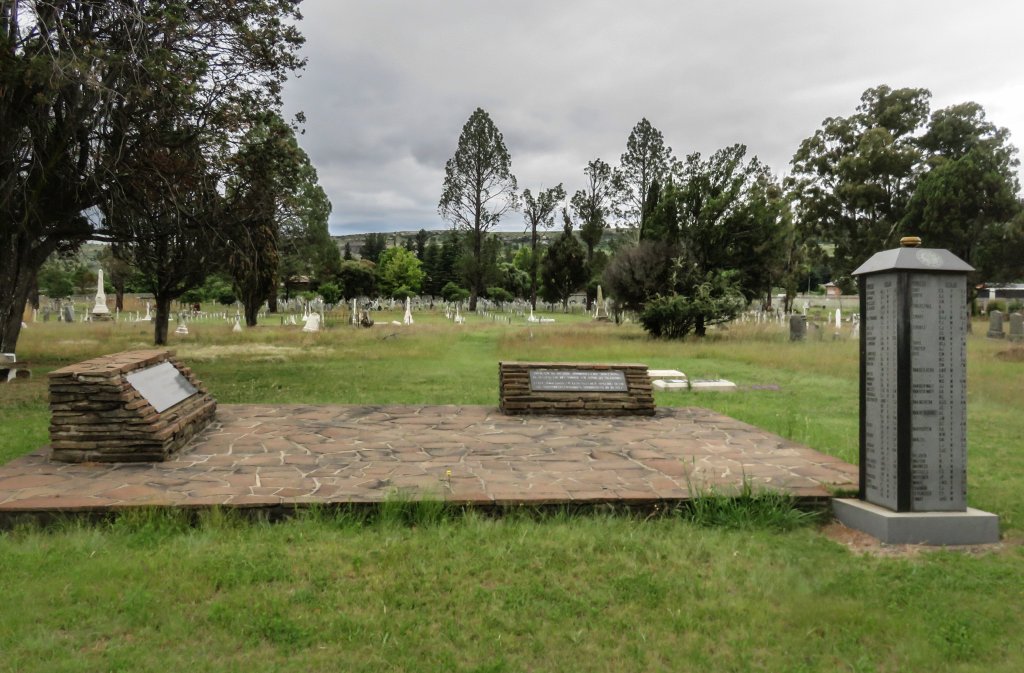 The Harrismith concentration camp existed from January 1901 to the end of May 1902. At its maximum it held about 1600 persons, women, children and old men. Conditions in the camp, as in many other camps, was not ideal. Resulting in death and desease, a peak was reached in December 1901 when 65 death were recorded.
The Harrismith concentration camp existed from January 1901 to the end of May 1902. At its maximum it held about 1600 persons, women, children and old men. Conditions in the camp, as in many other camps, was not ideal. Resulting in death and desease, a peak was reached in December 1901 when 65 death were recorded.
Jewish graves
 The Jewish section of the cemetery does contain a fair number of graves. It is an indication of the role Jewish business people played in the early development of the town.
The Jewish section of the cemetery does contain a fair number of graves. It is an indication of the role Jewish business people played in the early development of the town.
Basuto war graves

 Two gravestones of special interest, that of HO Dreyer and of J Simbeck. The text on the stones reads: Ter Gedagtenus aan; Hendrik Oosterwald; Dreyer; de vierden Zoon van; J.A.Dreyer; van Constantia; en kleinzoon van; T.F.Dreyer; van Wynberg; Kaap Kolonie; geboren te Constantia; den 4 October 1833; en gesneuveld en die; Basuto Oorlog; den 20 Maart 1866. Translated: to the memory of Henrik Oosterwald Dreyer, the 4th son of J.A.Dreyer of Constantia and grandson of T.F.Dreyer of Wynberg Cape colony at Constantia on the 4 October 1853 and died in the Basuto war on the 29 March 1866.
Two gravestones of special interest, that of HO Dreyer and of J Simbeck. The text on the stones reads: Ter Gedagtenus aan; Hendrik Oosterwald; Dreyer; de vierden Zoon van; J.A.Dreyer; van Constantia; en kleinzoon van; T.F.Dreyer; van Wynberg; Kaap Kolonie; geboren te Constantia; den 4 October 1833; en gesneuveld en die; Basuto Oorlog; den 20 Maart 1866. Translated: to the memory of Henrik Oosterwald Dreyer, the 4th son of J.A.Dreyer of Constantia and grandson of T.F.Dreyer of Wynberg Cape colony at Constantia on the 4 October 1853 and died in the Basuto war on the 29 March 1866.
The second grave stone, the one Piet is looking at, is in English and reads as follows: Sacred to the Memory of; Joseph Simbeck; who was born at Baireuth; in Bavaria December 25th; 1818; and fell in action near; Harrismith during the Basuto; war March 29th 1866; aged 47 years and 3 month; in the midst of life we are in death.
There is a bit of a story to these two graves. HO Dreyer originated from Constantia in the Cape, as a young man of 19 he left the Cape to seek his fortunes at the new gold diggings in Australia, that was 1852. When he came back, 1859, he settled in Harrismith. In Ref 3 it says that he acted as an agent, I am not sure what that means. Soon he owned the largest law firm in Harrismith. He was elected as a member of the volksraad (parliament) in 1863 and became its chairman 1866.
As a member of parliament he was not required to join the commando to fight in the Basuto war. This didn't stop him from forming his own commando of non-citizen to help with securing the area around Harrismith.
He led a number of expeditions to the Hoek (Witsieshoek area) where he captured livestock. Helping him were also a number of Batlokwas, who were living near Harrismith. There has been a long history of life stock theft from that area. His last expedition brought in about 1400 and was his most successful. But it also led to his demise. On the way back they were attacked and he and Joseph Simbeck lost their lives, he suffered 14 stab wounds and Simbeck 7.
Their bodies were taken back to Harrismith where they were interned with full military honours.
References
Ref 1.: Standard Encyclopedia of Southern Africa, Nasou Limited, 1974
Ref 2.: FA Steytler, Die Geskietenis van Harrismith, Nasionale Pers Beperk, 1932
Ref 3.: Leon Strachan, 'Blafboom-Legendes van 'n dorp', published by L.Strachan
Ref 4.:"Ons Kerk Album van Hollandsche Kerken en Leeraren", publisher: unknown, printed in the 1920's